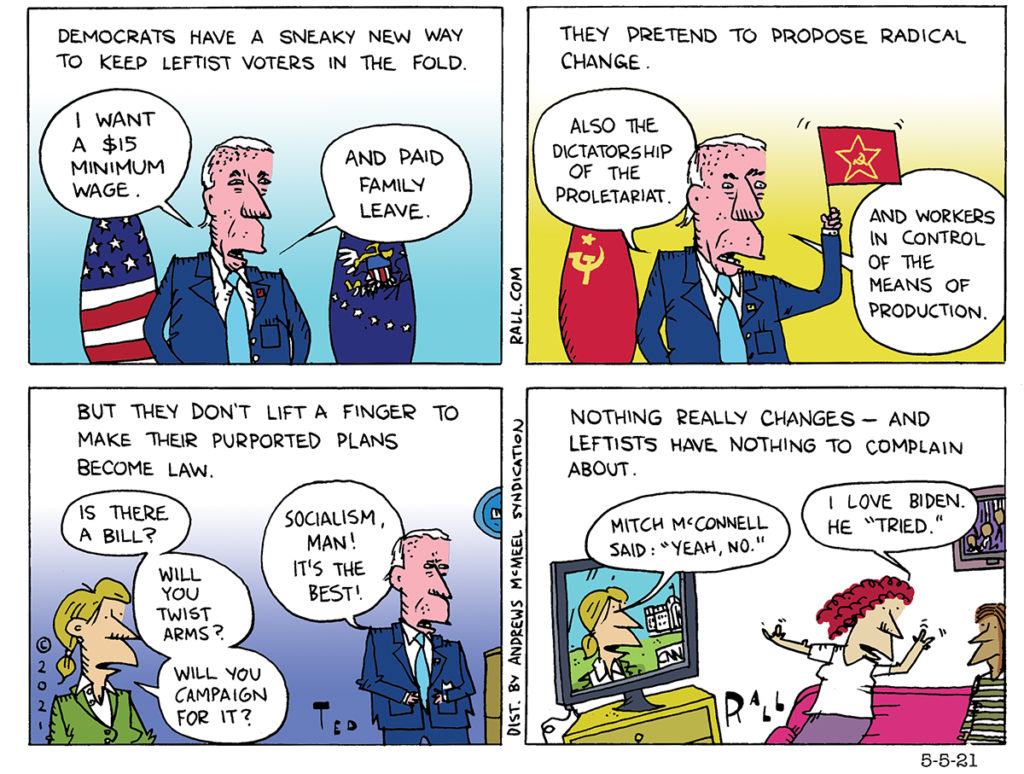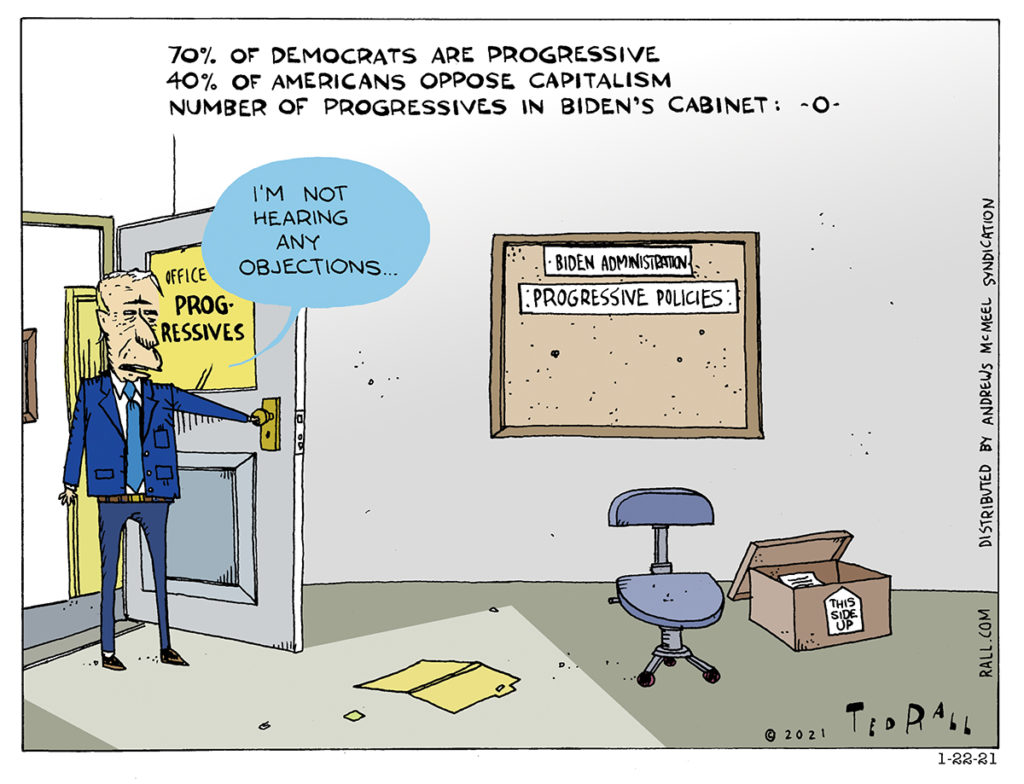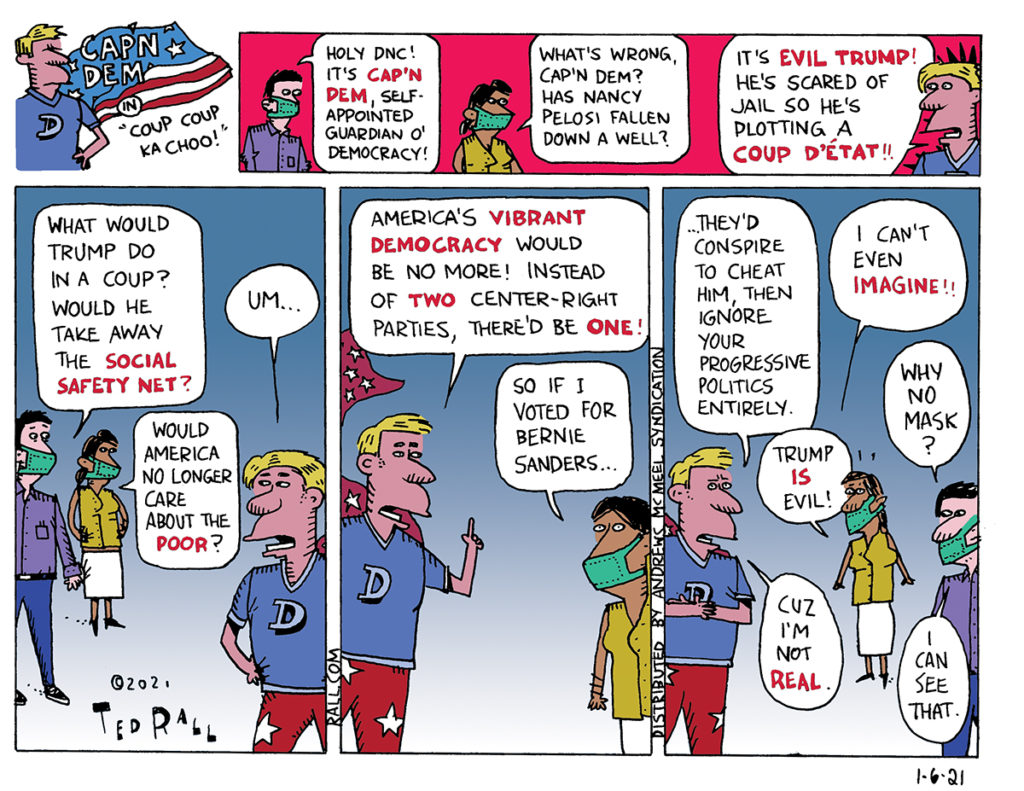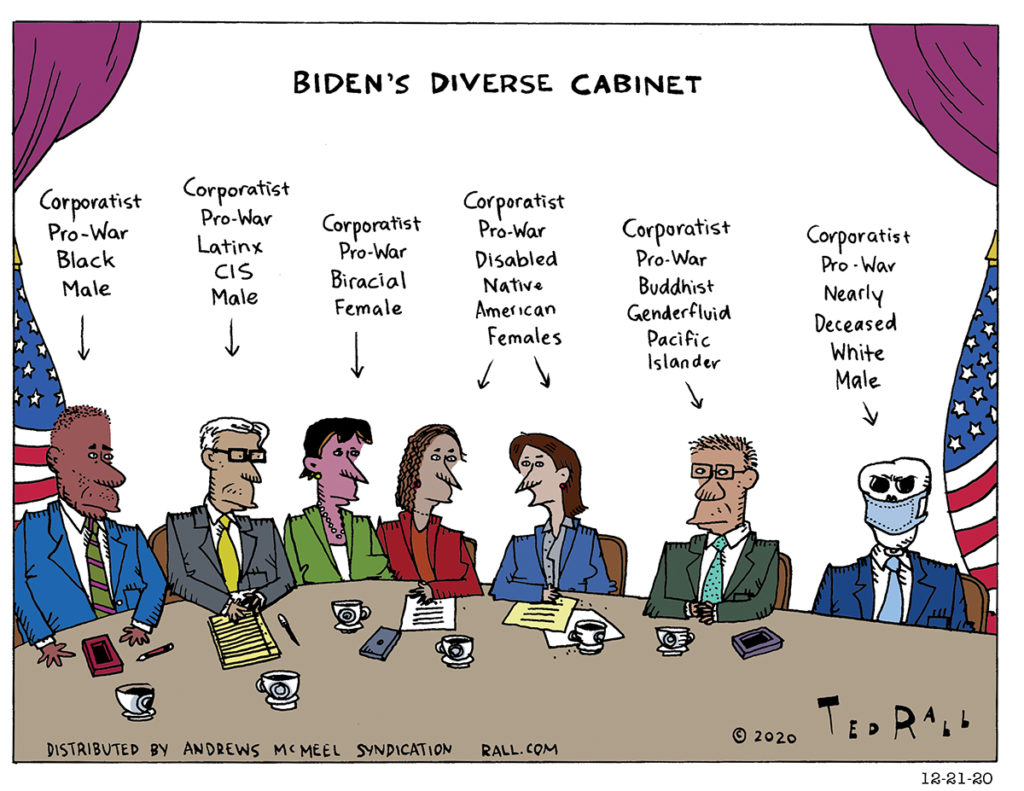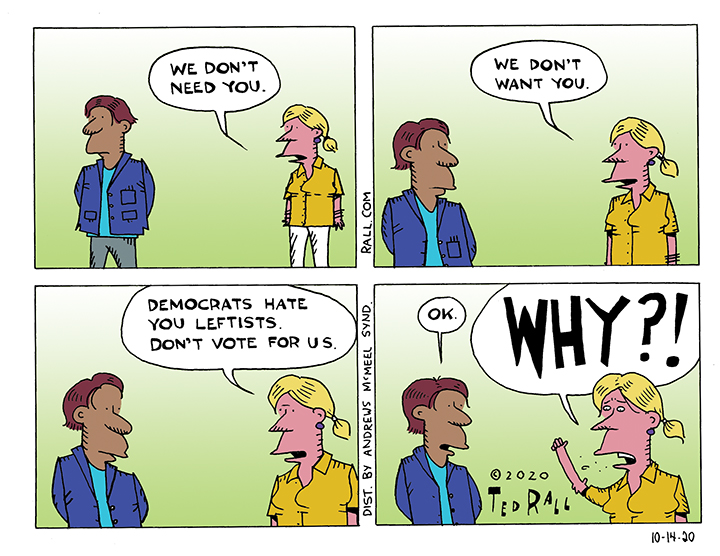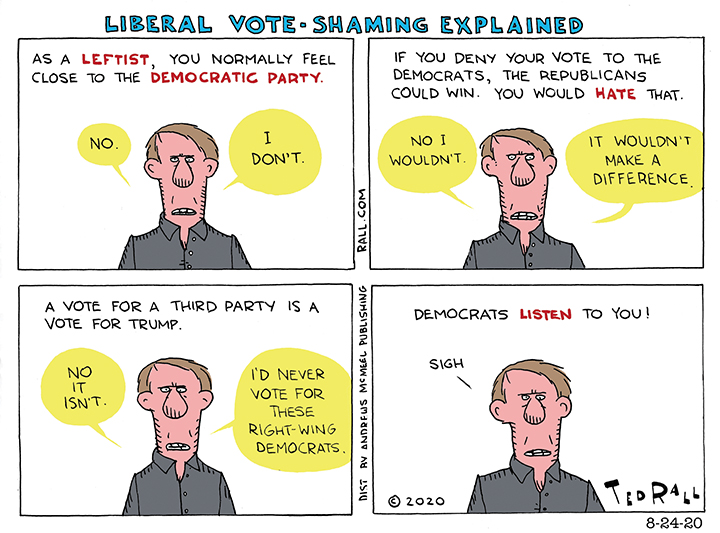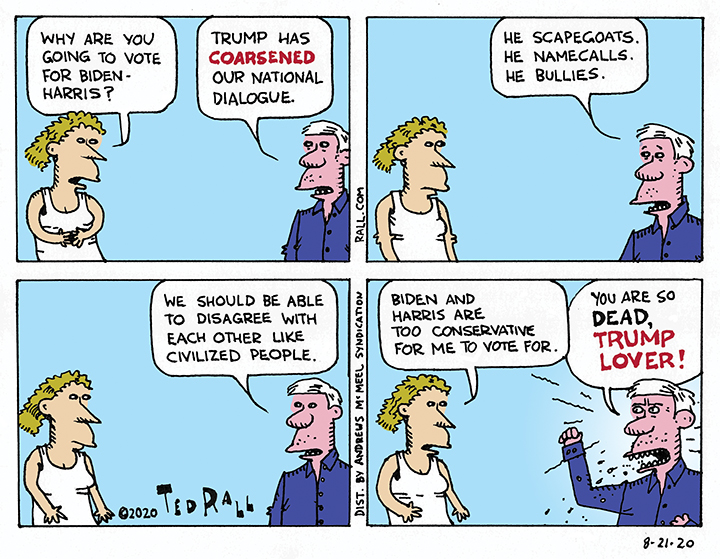The corporate centrists who control the Democratic Party have a sneaky new tactic to keep progressives inside the tent: they pretend to propose radical change but don’t do anything to enact it.
Democratic Progressivism Is a Dead Letter
Progressives did as they were asked and supported Joe Biden in big numbers. But they are completely out in the cold in the new administration. Their ideas are not represented. Nor are any of them in the new administration. So it’s highly unlikely that the new administration will enact any truly progressive policies.
Political Suicide: The Fight for the Soul of the Democratic Party
Publication Date: June 23, 2020
Ted Rall’s latest is a no-holds-barred look at the civil war raging within the Democratic Party in the graphic style of his national bestseller, Bernie.
There’s a split in the Democratic Party. Progressives are surging with ideas and candidates like Bernie Sanders, Elizabeth Warren and Alexandria Ocasio-Cortez. 72 percent of Democratic voters are progressives. But centrists like Tom Perez and the Clintons still run the DNC party apparatus–and they don’t want to compromise. Intraparty warfare exploded into the open in 2016. It’s even bigger now.
The struggle goes back decades, to the New Left and the election of Richard Nixon over George McGovern. It continued with the Democratic establishment’s quashing of insurgent progressives like Jesse Jackson, Ralph Nader and Howard Dean. The vast scale of the DNC’s secret conspiracy to stop Bernie Sanders in 2016 nomination came out courtesy of WikiLeaks.
Will Democrats again become the party of the working person? Or will the corporatists win and continue their domination of electoral politics? Ted Rall gets to the bottom of the story neither the Democrats nor the Republicans want you to know: how the civil war in the Democratic Party poses an existential threat to the two-party system.
Current Events/Biography, 2020
Seven Stories Press Paperback, 5″x7″, 192 pp., $16.95
Click here to Order Online.
Why We Need a New Progressive Party and How We Can Create It

There is no room for progressives in the Democratic Party.
No matter how many votes he or she gets, no progressive will be permitted to be the presidential nominee of the Democratic Party.
Progressives who try to work inside of, contribute to and support the Democratic Party have no real chance of moving its candidates or policies to the left.
Remaining inside the Democratic Party achieves nothing; to the contrary, it is insidiously counterproductive. Working for “change from the inside” strengthens centrist politicians who oppose progressivism with every fiber of their being.
If American electoral democracy has a future, and progressives want to be part of that future, there is only one way forward: create and build a new party in which progressivism isn’t merely tolerated or partly accommodated as some fringe or necessary nuisance but is its core mission.
We need a New Progressive Party.
The reason is simple: progressivism and corporate centrism are not parts of an ideological spectrum. Centrism isn’t watered-down progressivism; centrism directly opposes progressivism. Centrists want wars and don’t care about the poor; progressives want no wars and care deeply about the poor. There is no room for compromise between the two.
A New Progressive Party will go nowhere if, like the Green Party, it is poorly funded and disorganized and unable to field a slate of candidates across the board, from city council to state representative to congress. It must begin robustly, it must grow quickly, and it must be the only viable outlet for real progressives. Go big or go home.
This could be done. Now is the perfect time.
Keep reading. I’ll explain how.
Anyone who believes progressives have a place inside the Democratic Party should reflect on the experience of Bernie Sanders. (Those with an interest in recent history can delve into the dispiriting experiences of others who have tried to move the party left from the inside like Ted Kennedy, Jesse Jackson and Howard Dean, only to be ignored, snubbed and cheated.)
In both 2016 and 2020 Democratic-aligned media companies marginalized, misrepresented and deprived Sanders of coverage proportionate to his level of support in the polls. In 2016 the Democratic National Committee literally sold itself to Hillary Clinton’s center-right campaign apparatus, which conspired with the DNC to short Sanders on vote counts and deprive him of access to party data. In 2020 the DNC appears to have derailed Sanders’ frontrunner status by arranging for candidates Pete Buttigieg, Beto O’Rourke, Amy Klobuchar and others to drop out and endorse the Joe Biden one day before the key Super Tuesday primaries.
This is not one of those “better luck next time” scenarios. Sanders is too old to run again. AOC and her fellow progressive Squad are too young to mount a serious challenge to the DNC moderate hierarchy any time soon. Progressivism inside the Democratic Party is unlikely to again surge to Bernie levels for at least a decade.
Progressivism in general remains vibrant. Bernie Sanders has 31% of the 2020 primary popular vote. Elizabeth Warren, who has withdrawn, has 10%. Even if we assume that other former candidates like Pete Buttigieg didn’t get a single progressive vote — which isn’t likely — at least 41% of Democratic primary voters currently support progressivism. That makes about 20% of the electorate overall. Roughly 20% of non-voters, or about 9% of the total electorate, are progressive.
A New Progressive Party should therefore be able to count on roughly one of five voters out of the gate, with short-term potential of 30%. Not bad in a three-party system.
Now consider two factors that point to growth. As even corporate media concedes, progressive ideas like socialized medicine and a guaranteed living wage have suddenly exploded in popularity due to the coronavirus crisis and resulting economic freefall. Given the grim projections for the economy during the foreseeable future, 20-to-30% looks more like a floor than a ceiling.
There is greater potential of building a party from the grassroots than from the top down. Even while the presidency remains elusive, local politics are quirkier and thus offer opportunity for growth. Sanders began as mayor of Burlington; AOC won a surprise challenge to a long-time incumbent Democratic congressman in Queens. A Progressive farm team could and would spring up quickly in left-leaning college towns like Madison and Charlottesville.
But how? The D-R duopoly has rigged the system in its favor. Ballot access is tough. They control the presidential debates and coverage by the news media.
As I wrote above, funding is crucial. The fact that Bernie Sanders raised over $100 million so far in 2020 from small donors proves that progressives can raise cash for a cause they care about. So how do you start this new party?
The first step is to convene a founding meeting in a big venue like McCormick Place Convention Center. (Chicago is easy to get to from everywhere in the U.S.) Launch a Kickstarter to cover the cost of renting the hall; unless there are enough pledges to cover the total, no one has to pay up and the attempt is over. It serves as the first test of whether enough progressives are ready to break away from the Democratic Party.
The agenda of the first convention of the New Progressive Party will be dedicated to debating and agreeing to a platform, electing party officials and setting a strategy for the next election.
The newly-elected officials of the party then fan across the nation and start building local organizations in their own communities to recruit, fund and campaign for candidates to local and state office. Like the Democrats and Republicans, every four years there will be a national primary and convention to present a candidate for the presidency.
Some will argue that the creation of a party just for progressives will split the left. That assumes that the Democratic Party represents the left. The truth is exactly the opposite: the Democratic Party is where the American left goes to die. If the left wants to live, it must fight and struggle for the things that it cares about on its own, in its own home.
(Ted Rall (Twitter: @tedrall), the political cartoonist, columnist and graphic novelist, is the author of the biography “Bernie.” You can support Ted’s hard-hitting political cartoons and columns and see his work first by sponsoring his work on Patreon.)
A Premature Postmortem of the Bernie Sanders Campaign

Establishment media is ridiculing Bernie Sanders for stating some simple truths: establishment media was out to get him, the DNC was out to get him and young voters who support him haven’t been good about showing up at the polls.
But that doesn’t mean that Bernie Sanders didn’t make mistakes. So let’s take a look at those.
No matter what happens between him and Joe Biden, and it isn’t over yet, Sanders deserves credit for some remarkable achievements. In the face of formidable establishmentarian opposition, Jewish, with a speaking manner that is anything but conventional in U.S. politics, relying only on small individual donations and promoting a political agenda many Americans would consider radical, Bernie Sanders currently controls 42% of the Democratic primary vote against a recent sitting vice president. Much of his agenda, including making college affordable, increasing the minimum wage, and improving the healthcare system, has become mainstream Democratic Party policy after many decades during which the party didn’t even pretend to give a damn about normal people. Bernie Sanders is running an issue-based campaign, not one based purely on personality. Even if he loses, historians will mark this election as evidence of the strength of progressive and left-leaning electoral politics.
But he’s not perfect. There are things that he could have/could still do better.
Politics is first and foremost about framing, and Sanders isn’t great at it. “Medicare for All” is meaningless to millions of Americans who have had no contact with Medicare and don’t know anything about it. “Free healthcare” would have been easier to understand and would not have turned off or confused union members who already have decent healthcare plans. “Free college tuition,” on the other hand, tells too little of the story. Sanders’ plan only helps low-income college students but many voters seem to still think that he wanted to use their taxes to help out children of wealthy people. The “Green New Deal” hasn’t been defined or well-publicized beyond the fact that it would be expensive.
Sanders’ plan for student loan forgiveness was also presented in a problematic fashion. Many Americans don’t have college degrees; they wondered, why should we pay for those who do? Many other Americans went to college, took out student loans and then paid them back. Why shouldn’t millennials do the same? There are good answers to those questions: millennial student debt is many factors higher than Generation X and Baby Boomer debt because tuition has skyrocketed at a rate much faster than inflation. Student loan forgiveness would stimulate the economy by freeing up young people to buy cars and homes. People who already paid their loans should have been added as beneficiaries of his plan so that they didn’t feel like suckers due to a simple accident of birthdate. Most importantly, Sanders should not have proposed student loan forgiveness without coupling it to a free college tuition program and/or job retraining program for people who are older and don’t have college degrees or need retraining in order to retool for the 21st century.
Speaking of costs, I found it endlessly frustrating that Bernie Sanders never seemed able to clearly answer the question of how he would pay for his proposals. Generally, he should simply have said: “I’ll take it out of the Pentagon budget.” Maybe this wasn’t true. If it wasn’t true, he should have made it true. Not only is the defense budget bloated, most Americans, including people who favor strong military, know about the $800 toilet seats. I’m not sure why he didn’t bash the military.
He also hasn’t been good about explaining Medicare for All. What he should have said was, everyone is going to pay less for healthcare, so much less, that even though your taxes will go up a bit, you’ll still come out way ahead. And if you got hit by something catastrophic like cancer, it would all be covered. Instead, he talked about how European countries somehow managed to pay for national healthcare plans. He’s right about that, but Americans have been told that Europeans pay high taxes. He needed to explain in plain language that that would not happen here.
He ignored my advice to own and explain his self-described “democratic socialist” label. He probably assumed that it would be more of a problem in the general election against Donald Trump, but what he underestimated was the Democratic Party’s long history of red bashing as well as the well-established fact that other people will define you if you don’t do it yourself. He should have followed the example of JFK when he gave a speech assuring Americans that he would not take orders from the pope as a Roman Catholic. Sanders should have given a speech entirely about democratic socialism.
Some things, it’s hard to do anything about. A campaign has the candidate that it has with a personality that he or she comes with. Bernie Sanders has an underlying vulnerability and warmth that his tendency to bellow often covered up. The media had a field day portraying him as a guy who likes to yell a lot. This is where something like “The Man from Hope” video that the Bill Clinton for President campaign created would have come in handy. A biographical look at Bernie’s roots in Brooklyn, his childhood struggling in a working-class family and the premature death of his mother due to poor healthcare would have helped to humanize a very human person.
Images of him being manhandled by cops during his participation in the civil rights movement of the early 1960s couldn’t have hurt him with African-American voters who ended up turning out for Joe Biden.
Of course the biggest mistake Sanders made may not have been a mistake at all. He ran inside the Democratic Party. They were never going to let him have the nomination.
He had to know that.
(Ted Rall (Twitter: @tedrall), the political cartoonist, columnist and graphic novelist, is the author of the biography “Bernie.” You can support Ted’s hard-hitting political cartoons and columns and see his work first by sponsoring his work on Patreon.)

